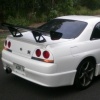Rb 25 Neo Turbo, Is It Worth It?
Announcements
-
Similar Content
-
Latest Posts
-
I have a heap that i have collected if you want some authentic ones still. Pm me if your interested!
-
Hey lads, reviving an old thread. As an update, since the last time replied to this thread, ive done mostly suspension. Havent touched the motor except for maintenance. Though upon changing spark plugs, found out i had splitfires pre-installed! Updates: - Got me some stock airbox top cover and snorkel to fit onto the original intake. Should be free of defects - Bought a set of R34 GT-T brakes (not installed yet, going to rebuild + respray in champion blue + white 'Nissan' text) - Bought the last set of bilsteins from @Sydneykid and had them installed. Has been making some sounds on the rear but hopefully should be sorted out after this New Year break. - Regreased front caster rod bushings (poly bushes..) - Rear upper camber arms - Whiteline sway bars (BNF27Z 22mm + BNR11XXZ 24mm). The rear sway bars are a bit short (ive read 50mm else where) but was still able to get them in. Anyhows, I reckon suspension is sorted now. Maybe replace bushes (do have a set of front upper control arms from SK not installed yet) but should be okay for now. From now, I'm wanting to start working on the motor, drivetrain etc etc. Still debating on the order to go on and what to buy etc but: - ECU ( Haltech or Link ( Link states that it dont support A/T or AWD functions... Can anyone attest to this? ) - Highflow turbo ( ATR43ss2 ) - Intercooler ( Not decided yet, but cant find many good afoordable ones. Toshi says to opt for crossflow Japanese. Bit difficult this one, unless I get a returnflow Blitz from JJ? ) - Injectors ( Any recommendations ? I do have a nismo FPR ( Thanks SK ) ) - Seats - Tune by either Toshi or DVS To be fair, I did consider just keeping the stock turbo and nistuning it. Sat in a mates stock N, that had something like 200kw, and I reckon that felt more than enough. Maybe I should just go this route ahhaha. Too many choices.... Planning a trip down south, so wanting to just clean things up and make sure it gets to and from in one piece. Anything else specifically I should do before ? Cheers lads
-
By DraftySquash · Posted
Must be for the car’s lucky charm 🤷🏽♂️ She runs fine, but it just seems to take about 1L less. Maybe I’ll have the oil sump dropped at some point to check if there is anything
-





Recommended Posts
Create an account or sign in to comment
You need to be a member in order to leave a comment
Create an account
Sign up for a new account in our community. It's easy!
Register a new accountSign in
Already have an account? Sign in here.
Sign In Now